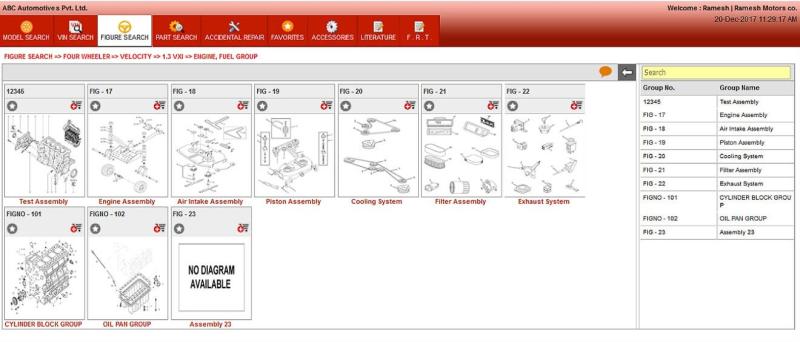5 Advantages of Advanced Search in Digital Parts Catalogs

The aftermarket industry has seen steady growth over the past few years and continues to become more efficient. To keep this growth up and running with maximum efficiency, it is necessary to introduce more efficient methods of catalog management that promote quick response and minimum downtime.
It has effectively solved this gap in the aftermarket between OEMs (original equipment manufacturers) and dealers, improving overall operational efficiency. To understand the advanced search features better, we first need to know what the software is.
What is a Digital Parts Catalog?
Computerized parts lists have been a major leap in the aftermarket industry. The software provides users with an interactive and easy-to-navigate system to search, identify, and place an order for the required parts. AI voice search, VIN search, and figure search are examples of how the software has drastically reduced downtime and increased efficiency.
Besides easy search features, the software also includes 2D and 3D demonstrations of the parts for the user to locate the parts they require. Now that we know the purpose of a digital parts catalog, let us understand the advantages of its advanced search features and their contribution to the aftermarket.
Why Advanced Search Features Play a Crucial Role?
Reduces Equipment Downtime
Interactive parts catalog software provides real-time data on every available part, along with its compatibility and availability. Its advanced features allow dealers to better forecast and ensure that critical parts that are in high demand are always available.
Easy access to information without having to go through a pile of documentation helps reduce downtime and maximize efficiency.
AI Search Feature
This AI search feature operates based on simplifying machine learning and advanced algorithms. The identification process becomes faster and more efficient by simply taking a picture or describing the physical appearance of the required part through text and voice.
The information fed to the software, which could be in the form of an image, is quickly analyzed by AI. The software compares it with the existing set of images in the database and identifies the exact part with minimal chances of error.
Reduces Operational Costs
OEMs and dealers can easily save money with the help of an efficient digital parts catalog.
Overstocking and Understocking:
Digital parts catalog provides systematic and real-time data on parts, day-to-day availability, and access to accurate information. With the help of this data, dealers can cut down on overstocking and mismanagement.
Another major challenge in maintaining an inventory is understocking, which involves extra payments to get a particularly rare part shipped in a lower quantity.
Duplicate Orders:
Different parts have different identifications which make them unique, but all differences are not visible or cannot be identified easily such as the year it was manufactured or a variant of a similar product.
Advanced search features help in navigating through different parts and models with ease and locate the exact part in the catalog. This reduces the chances of placing duplicates as well as wrong orders.
Non-Negotiable Deals in Bulk Purchasing:
The software records accurate information about trends in demand for parts, which simplifies the requirement of bulk purchasing and saves warehouse and investment costs. When the bulk purchase does not align with the company’s budget, it can lead to higher overall expenditures, further affecting the expenses. This can lead to financial inflexibility and increased inventory costs.
Equipment Downtime:
Swift identification and management of orders drastically decreases the downtime of any service, which helps in maintaining credibility in the aftermarket and retaining more customers. There are several cost factors associated with emergency repairs and expenditures that result in increased maintenance.
Improper management of inventory can lead to extensive financial repercussions. Additionally, halts in production will result in employees being resigned to other tasks, leading to increased labor costs.
Efficient Supersession Management
Supersession management automatically updates the parts that have been replaced and discontinued, ensuring the availability of the most compatible parts. The software becomes the single ideal platform for managing all recent revisions and updates that are constantly applied to each part.
It keeps track of all the different versions of the parts to ensure accuracy in referring to the history of a part. Manual errors are significantly reduced as the software automatically synchronizes the latest revisions.
The dependency on outdated information or techniques is greatly reduced, allowing the dealers to make a more informed decision.
5. Personalized Search Options
The availability of the software in more than nine languages ensures that it is more accessible to a large number of audiences across the world. Multilingual accessibility caters to the needs of OEMs and dealers for more accurate results. With personalized search and language options, the overall time is reduced while efficiency is increased.
Nurture Better Customer Relations With Minimal Downtime!
With the help of advanced search features in digital parts catalog software, OEMs can easily manage upfront costs, increased storage expenses, and potential risks. Supersession management speeds up repairs and strengthens the dealer’s relationship with their customers.
Integrating the AI parts catalog and advanced search options has made the overall customer experience smoother and hassle-free. With voice-activated search, predictive analytics, and IoT integration, the aftermarket is yet to witness better management in the coming years.
Post Your Ad Here

Comments